Bhushan B. Handbook of Micro/Nano Tribology, Second Edition
Подождите немного. Документ загружается.

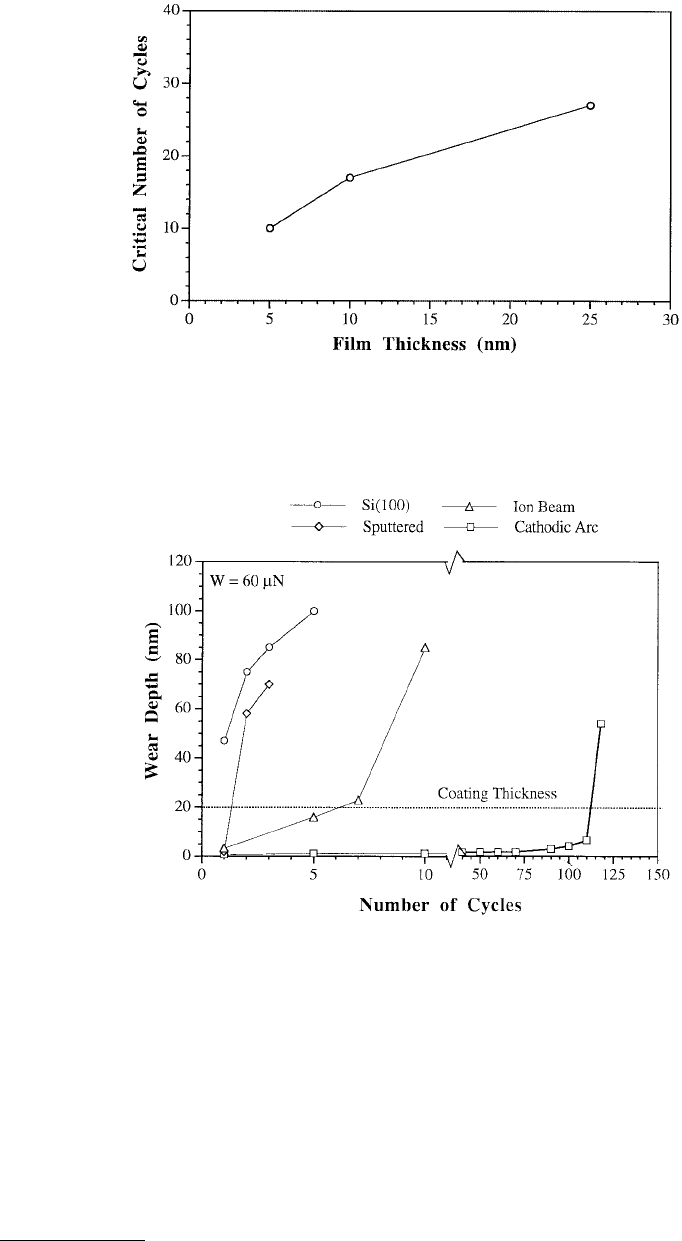
© 1999 by CRC Press LLC
lubricant thickness at that point. (The measured thickness is about 2 nm larger than the actual thickness
due to a thin layer of lubricant wetting the tip, Mate et al., 1990). When the sample is withdrawn, the
forces on the tip slowly decrease to zero as a long meniscus of liquid is drawn out from the surface.
Particulate disks were mapped by Mate et al. (1990) and Bhushan and Blackman (1991). The distri-
bution of lubricant across an asperity was mapped by collecting force-vs.-distance curves with the AFM
in a line across the surface. A particulate disk was coated with nominally 20 to 30 nm of lubricant, but
by AFM the average thickness was 2.6 ± 1.2 nm. (The large standard deviation reflects the huge variation
of lubricant thickness across the disk.) A large percentage of the lubricant is expected to reside below the
FIGURE 14.37 Critical number of cycles (above which wear increases rapidly) as a function of thickness of sputtered
carbon coatings on magnetic disks at 20 µN load.(From Bhushan, B. and Koinkar, V.N., 1995, Surf. Coat. Technol.
76–77, 655–669. With permission.)
FIGURE 14.38 Wear depth as a function of number of cycles at 60 µN load for uncoated single-crystal silicon and
20-nm-thick coatings deposited by sputtering, ion beam, and cathodic arc carbon processes. (From Koinkar, V.N.
and Bhushan, B., 1997, Proc. Inst. Mech. Eng. Part J: J. Eng. Tribol. 211, 365–372. With permission.)
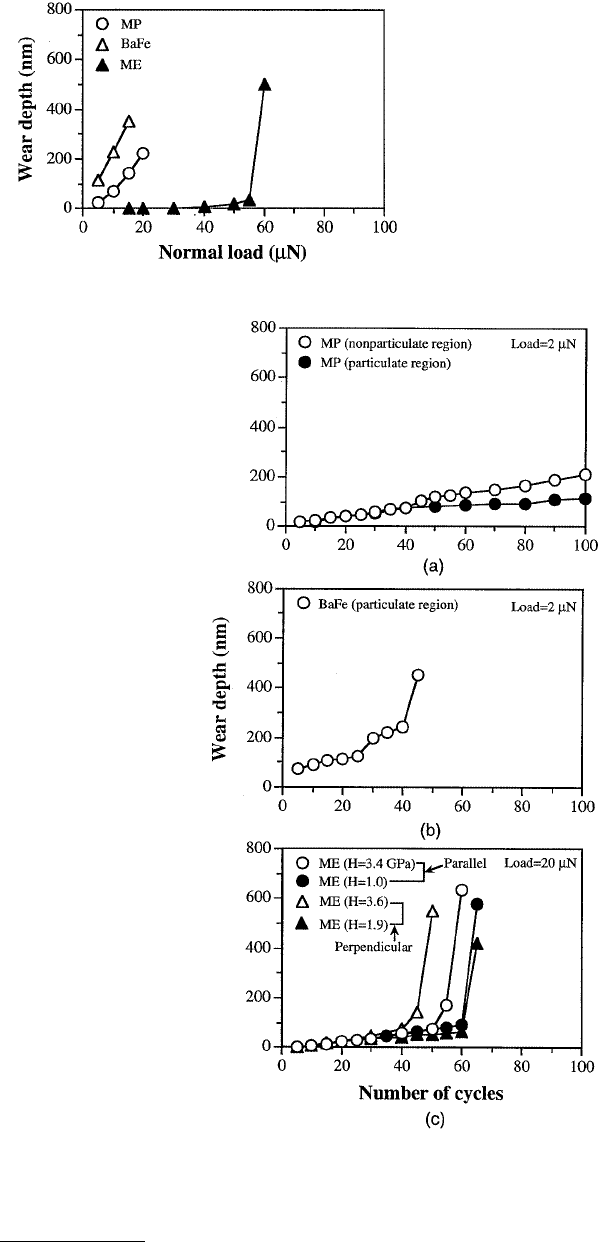
© 1999 by CRC Press LLC
FIGURE 14.39 Wear depth as a function of normal
load for three tapes in the parallel direction after one
cycle. (From Bhushan, B. and Koinkar, V.N., 1995,
Wear 181–183, 360–370. With permission.)
FIGURE 14.40 Wear depth as a function of number of cycles for (a) MP, (b) BaFe, and (c) ME tapes in different
regions at normal loads indicated in the figure. Note a higher load used for the ME tape in (c). (From Bhushan, B.
and Koinkar, V.N., 1995, Wear 181–183, 360–370. With permission.)

© 1999 by CRC Press LLC

© 1999 by CRC Press LLC
surface in the pores. In Figure 14.60, we show histograms of lubricant thickness across three regions on
the disk. The light part of the bar represents the hard wall of the substrate and the dark part of the top
is the thickness of the lubricant. Each point on the histogram is from a single force-vs.-distance mea-
surement, with points separated by 25-nm steps. The lubricant is not evenly distributed across the surface.
In regions 1 and 2 there is more than twice as much lubricant than there is on the asperity (region 3).
There are some points on the top and the side of the asperity which have no lubricant coating at all
(Bhushan and Blackman, 1991).
14.8.3 Boundary Lubrication Studies
To study lubricant depletion during microscale measurements, Koinkar and Bhushan (1996b) conducted
nanowear studies using Si
3
N
4
tips. They measured friction as a function of number of cycles for virgin
silicon and silicon surface lubricated with Z-15 and Z-Dol lubricants, Figure 14.61. An area of 1 × 1 µm
was scanned at a normal force of 300 nN. Note that the friction force in a virgin silicon surface decreases
in a few cycles after the natural oxide film present on silicon surface gets removed. In the case of Z-15-
coated silicon sample, the friction force starts out to be low and then approaches that of an unlubricated
silicon surface after a few cycles. The increase in friction of the lubricated sample suggests that the
lubricant film gets worn and the silicon underneath is exposed. In the case of the Z-Dol-coated silicon
sample, the friction force starts out to be low and remains low during the 100-cycle test. It suggest that
Z-Dol does not get displaced/depleted as readily as Z-15. (Also see Bhushan et al., 1995g.) Microwear
studies were also conducted using the diamond tip at various loads. Figure 14.62 shows the plots of wear
depth as a function of normal load and Figure 14.63 shows the wear profiles of worn samples at 40 µN
normal load. The Z-Dol lubricated sample exhibits better wear resistance than unlubricated and Z-15-
lubricated silicon samples. Wear resistance of the Z-15-lubricated sample is little better than that of the
unlubricated sample. The Z-15-lubricated sample shows the debris inside wear track. Since the Z-15 is
a liquid lubricant, debris generated is held by the lubricant and it becomes sticky which moves inside
the wear track and does damage, Figure 14.63.
14.9 Closure
AFM/FFM have been successfully used for measurements of surface roughness, friction, adhesion,
scratching, wear, indentation, detection of material transfer, and lubrication on micro- to nanoscales.
Commonly measured roughness parameters are scale dependent, requiring the need of scale-independent
fractal parameters to characterize surface roughness. A generalized fractal analysis is presented which
allows the characterization of surface roughness by two scale-independent parameters. Measurements of
nanoscale friction of a freshly cleaved, highly oriented pyrolytic graphite exhibited the same periodicity
as that of corresponding topography. However, the peaks in friction and those in corresponding topog-
raphy were displaced relative to each other. Variations in atomic-scale friction and the observed displace-
ment can be explained by the variations in interatomic forces in the normal and lateral directions. Local
variation in microscale friction force is found to correspond to the local surface slope, suggesting that a
ratchet mechanism is responsible for this variation. Directionality in the friction is observed on both
micro- and macroscales which results from the surface preparation and asymmetrical asperities on the
surface. Microscale friction is generally found to be smaller than the macroscale friction as there is less
plowing contribution in microscale measurements.
FIGURE 14.41 Surface maps showing the worn region (center 2 × 2 µm) after various cycles of wear at (a) 2 µN for
MP (particulate region) and at (b) 20 µN for ME (H = 3.4 GPa, parallel direction) tapes. Note a different vertical
scale for the bottom profile of (b). (From Bhushan, B. and Koinkar, V.N., 1995, Wear 181–183, 360–370. With
permission.)

© 1999 by CRC Press LLC
Wear rates for particulate magnetic tapes, polyester tape substrates, and single-crystal silicon are
approximately constant for various loads and test durations. However, for magnetic disks and magnetic
tapes with a multilayered thin-film structure, the wear of the DLC overcoat in the case of disks and
magnetic layer in the case of tapes is catastrophic. Breakdown of thin films can be detected with AFM.
Evolution of the wear has also been studied using AFM. We find that the wear is initiated at nanoscratches.
Amorphous carbon films as thin as 5 nm are deposited as continuous films and exhibit some wear life.
Wear life increases with an increase in film thickness. Carbon coatings deposited by cathodic arc process
are superior in wear and mechanical properties followed by ion beam and sputtering processes. AFM
has been modified for nanoindentation hardness measurements with depth of indentation as low as
1 nm. Scratching and indentation on nanoscales are powerful ways of evaluation of the mechanical
integrity of ultrathin films. Detection of material transfer on a nanoscale is possible with AFM.
Measurement of lubricant film thickness with a lateral resolution on a nanoscale and boundary
lubrication studies have been conducted using AFM. AFM/FFM friction experiments show that lubricants
with polar (reactive) end groups dramatically increase the load or contact pressure that a liquid film can
support before solid–solid contact and thus exhibit long durability.
Friction and wear on micro- and nanoscales have been found to be generally smaller compared with
that at macroscales. Therefore, micro/nantribological studies helps define regimes for ultralow friction
and zero wear.
FIGURE 14.42 Wear depth as a function of normal load (after one cycle) for a PET film. (From Bhushan, B. and
Koinkar, V.N., 1995, Tribol. Trans. 38, 119–127. With permission.)
FIGURE 14.43 Wear depth as a function of number of cycles at 1 µN for a PET film. (From Bhushan, B. and
Koinkar, V.N., 1995, Tribol. Trans. 38, 119–127. With permission.)
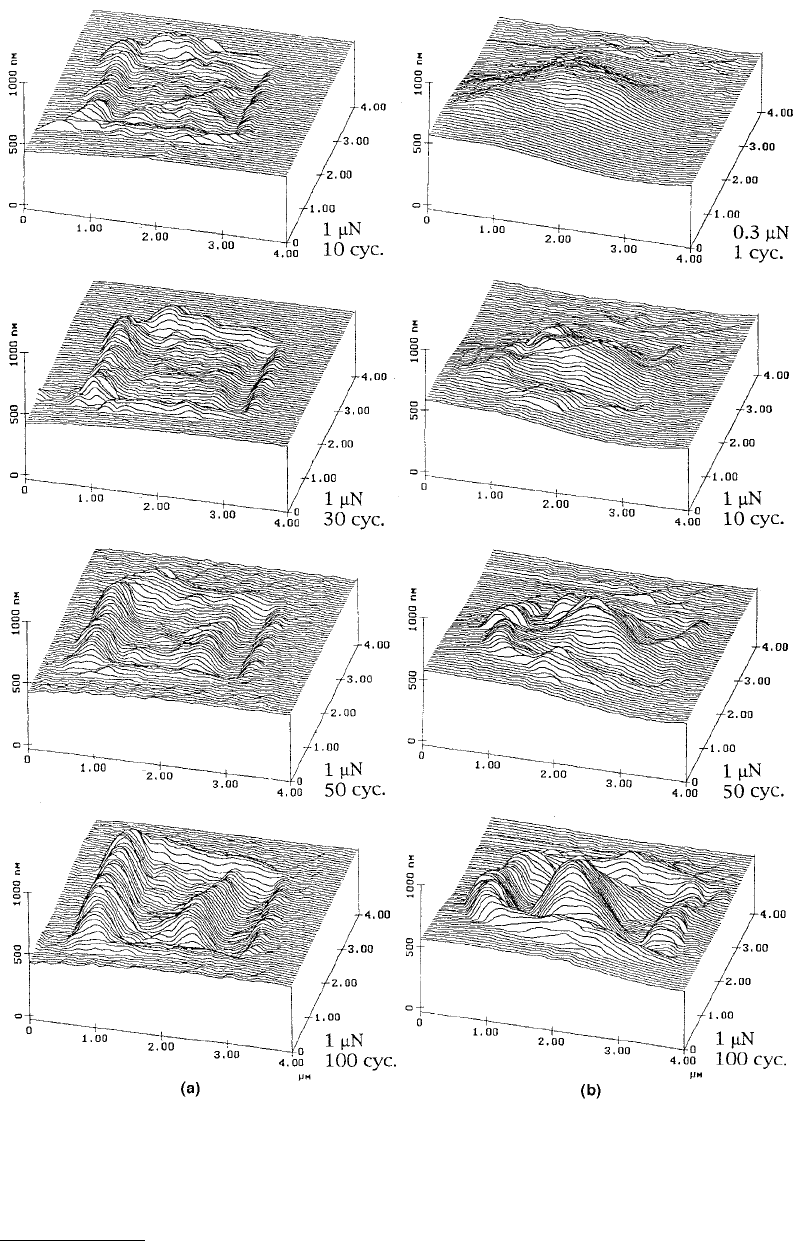
© 1999 by CRC Press LLC
FIGURE 14.44 Surface maps showing the worn region (center 2 × 2 µm) at 1 µN for a PET film (a) in the polymer
region, and (b) in the particulate region. The number of cycles are indicated in the figure. (From Bhushan, B. and
Koinkar, V.N., 1995, Tribol. Trans. 38, 119–127. With permission.)
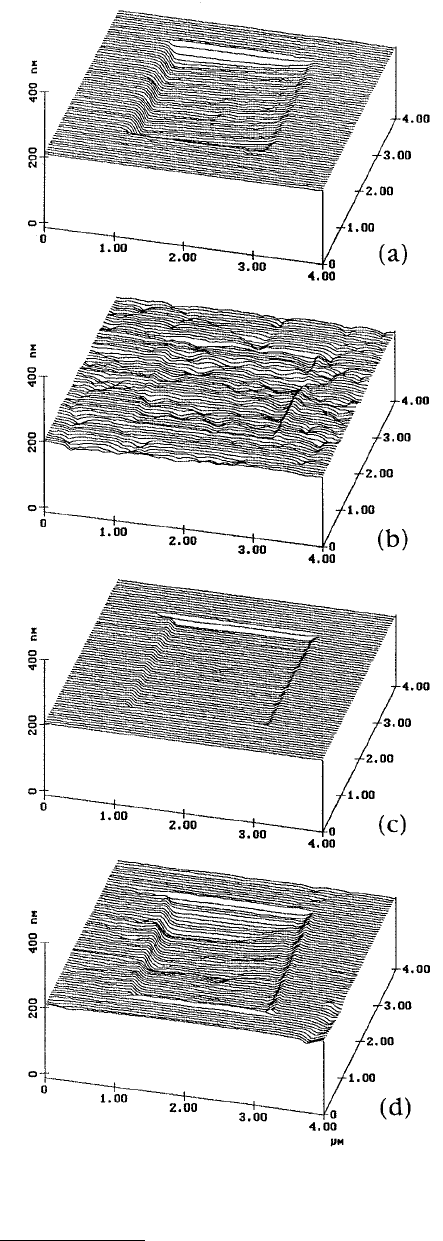
© 1999 by CRC Press LLC
FIGURE 14.45 Surface maps showing the
worn region (center 2 × 2 µm) after one cycle
of wear at 40 µN load (a) Si(111), (b) PECVD-
oxide-coated Si(111), (c) dry-oxidized Si(111),
and (d) C
+
-implanted Si(111). (From Bhus-
han, B. and Koinkar, V.N., 1994, J. Appl. Phys.
75, 5741–5746. With permission.)
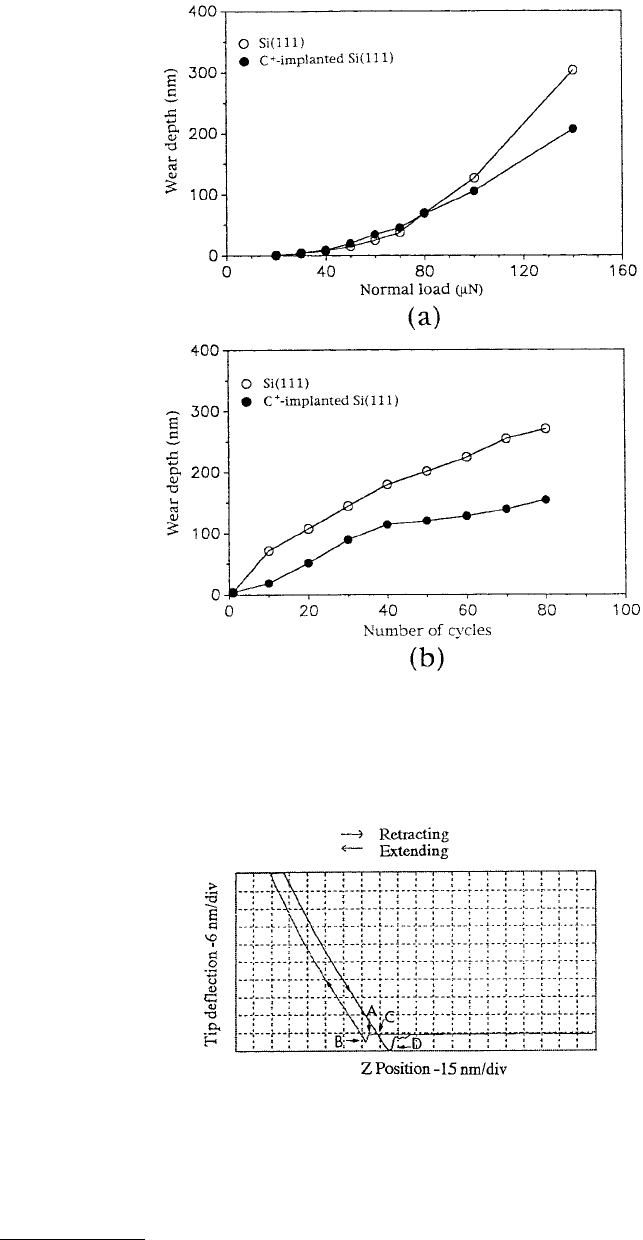
© 1999 by CRC Press LLC
FIGURE 14.46 Wear depth as a function of (a) normal load (after one cycle), and (b) number of cycles (normal
load = 40 µN) for Si(111) and C
+
-implanted Si(111). (From Bhushan, B. and Koinkar, V.N., 1994, J. Appl. Phys. 75,
5741–5746. With permission.)
FIGURE 14.47 Tip deflection (normal force) as a function of Z (separation distance) curve for an MP tape. The
spring constant of the cantilever used was 0.4 N/m. (From Bhushan, B. and Ruan, J., 1994, ASME J. Tribol. 116,
389–396. With permission.)
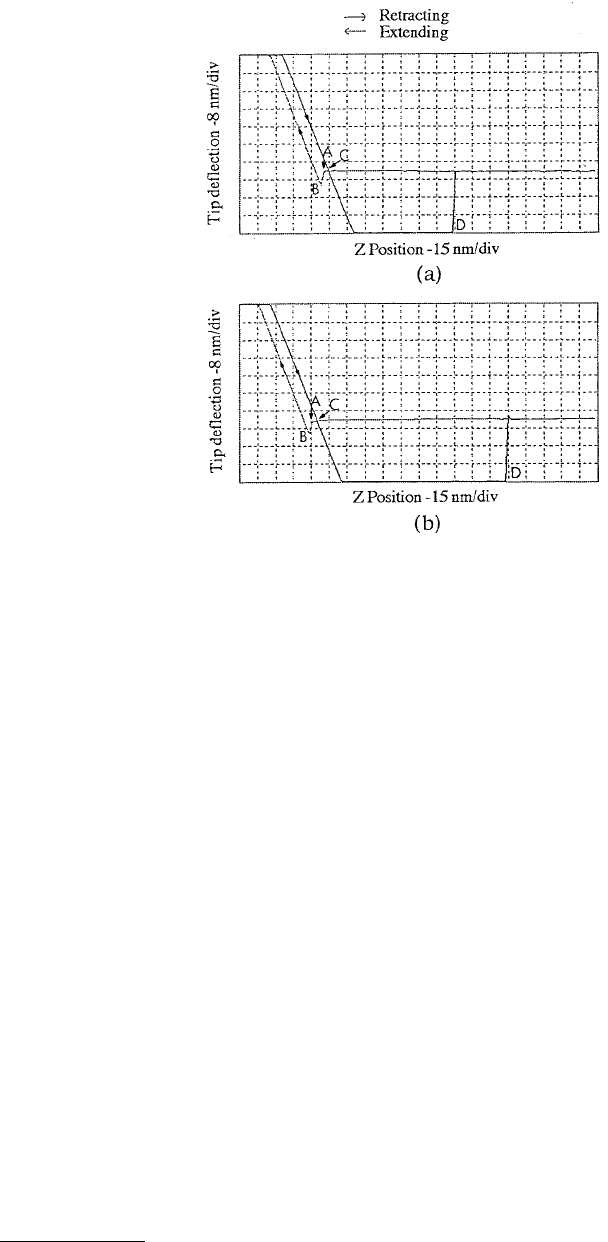
© 1999 by CRC Press LLC
FIGURE 14.48 Tip deflection (normal force) as a function of Z (separation distance) curve for (a) unlubricated
and (b) lubricated textured thin-film rigid disks. The pull-off force is 42 nN for the unlubricated disk and 64 nN
for the lubricated disk calculated from the horizontal distance between points C and D and the cantilever spring
constant of 0.4 N/m. (From Bhushan, B. and Ruan, J., 1994, ASME J. Tribol. 116, 389–396. With permission.)
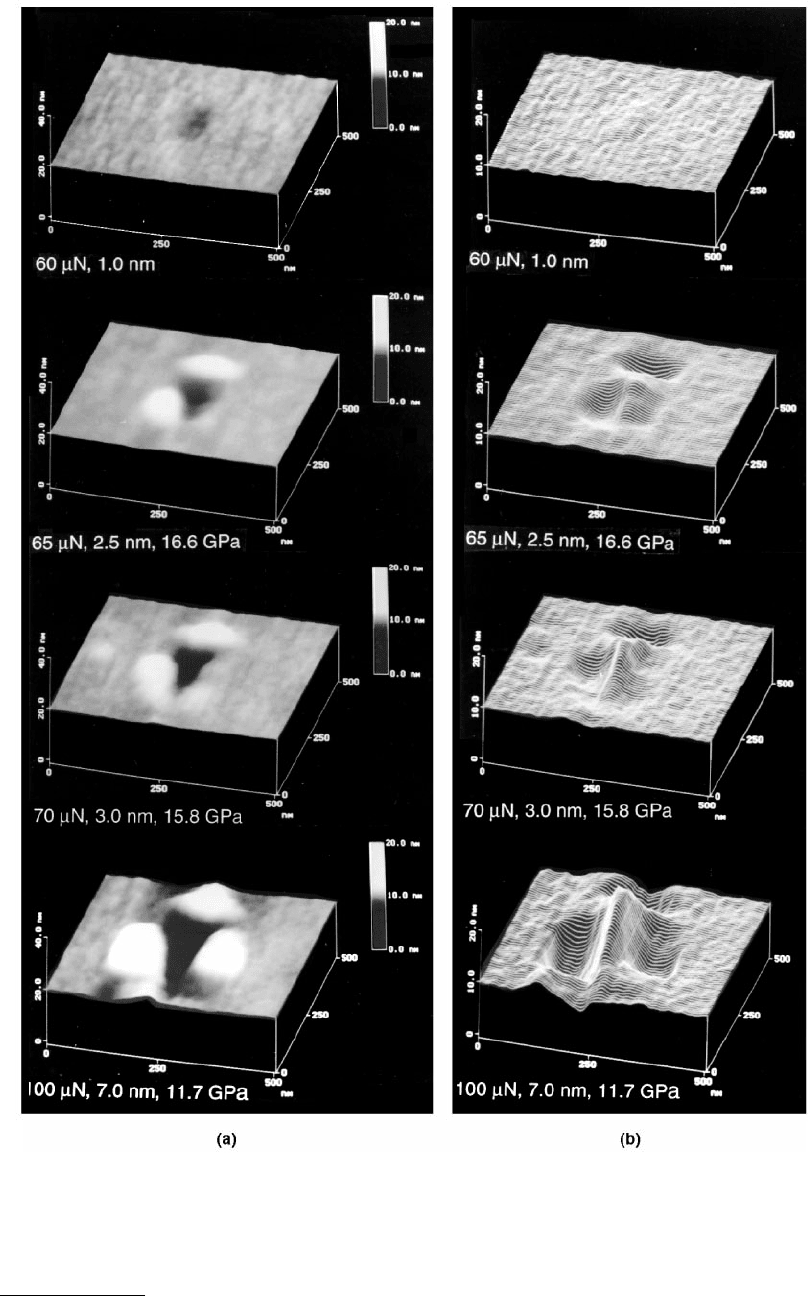
© 1999 by CRC Press LLC
FIGURE 14.49 (a) Gray-scale plots and (b) line plots of inverted images of indentation marks on the as-received
Si(111) sample at various normal loads. Loads, indentation depths, and hardness values are listed in the figure. (From
Bhushan, B. and Koinkar, V.N., 1994, Appl. Phys. Lett. 64, 1653–1655. With permission.)
